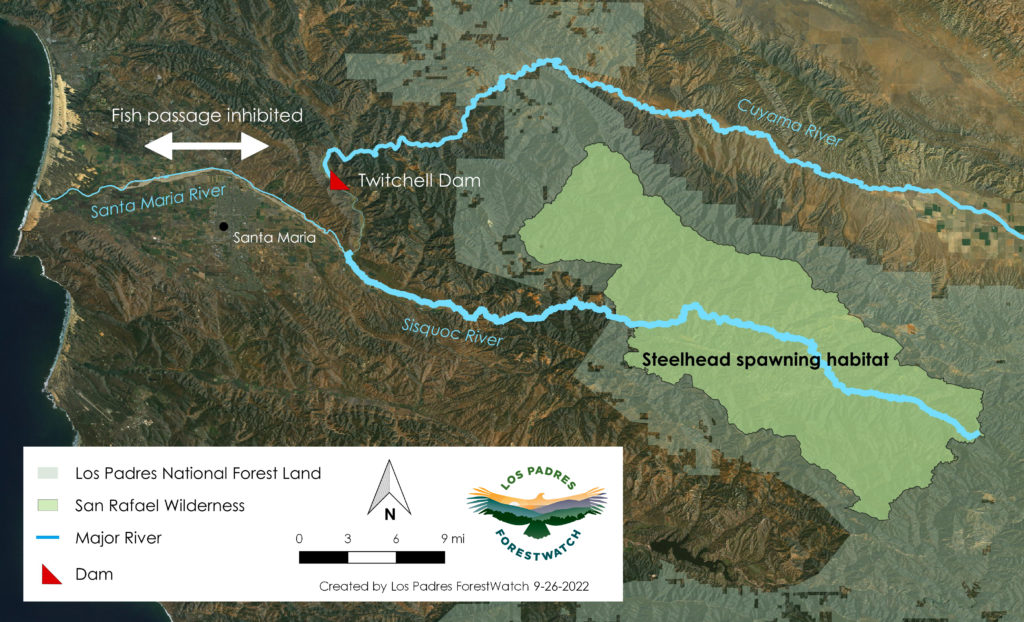WASHINGTON – The U.S. Supreme Court today denied a request from the operators of Twitchell Dam to avoid protecting the endangered Southern California steelhead in the Santa Maria River system. This is a big win for steelhead, for the watershed, and for our local communities.
Today’s decision leaves in place last year’s ruling by the 9th U.S. Circuit Court of Appeals holding that the Bureau of Reclamation (“Bureau”) and the Santa Maria Valley Water Conservation District (“the District”) can release water from the Dam to comply with the ESA. This ruling was in response to a lawsuit filed by Plaintiffs San Luis Obispo Coastkeeper and Los Padres ForestWatch in 2019, represented by the Environmental Defense Center, Sycamore Law, Inc., and Aqua Terra Aeris Law Group. The case alleged that the Dam’s operators are violating the Endangered Species Act (“ESA”) by limiting the quantity and timing of flows in the Santa Maria River to levels that harm the critically-imperiled steelhead population.
“The Supreme Court’s decision is an important step in the effort towards restoring endangered steelhead to this critically important watershed, where fish once numbered in the thousands,” said ForestWatch executive director Jeff Kuyper. “With simple changes to the Dam’s water release schedule, we can give fish a fighting chance at reaching their historic spawning grounds in Los Padres National Forest while maintaining plentiful water supplies for our farms and communities.”
The Bureau and District claimed that they were prohibited from releasing water for fish based on the 1954 legislation that authorized construction of the Dam. Although the district court ruled for the Dam operators, plaintiffs appealed that ruling and won in the 9th Circuit Court of Appeals. The Ninth Circuit noted that the “current operation of Twitchell Dam harms Southern California steelhead by impairing their ability to migrate and reproduce.” The Court went on to hold that operation of the Dam must comply with both the law authorizing the Dam and the ESA. As the Court ruled, “the Agencies have discretion to operate Twitchell Dam for other purposes besides irrigation, conservation, and flood control—including, potentially, adjusting water discharges to support the migration and reproduction of Southern California steelhead.”
Twitchell Dam was constructed in the 1950s, and is located on the Cuyama River, the northern tributary to the Santa Maria River. The operation of Twitchell Dam limits the timing and quantity of flows in the mainstem of the Santa Maria River, preventing steelhead from migrating to and from the ocean and upstream spawning habitat, as the following map depicts. Without adequate flows, fish are unable to complete this process and become stranded in the dry river system.
“This decision is a critical step toward recovering steelhead—one of the most endangered fish species in the United States. The Supreme Court ruling puts an end to the Twitchell Dam operators’ arguments that their hands are tied and that they can avoid compliance with the Endangered Species Act at the expense of steelhead,” said Maggie Hall, Deputy Chief Counsel for the Environmental Defense Center, which represents Los Padres ForestWatch.
“Instead of making modest changes to Dam operations that would allow steelhead to migrate to and from the Ocean, the Bureau and the District have wasted over three years and countless resources arguing they have no obligation to comply with the clear requirements of the ESA. That tactic has failed,” said Erica Maharg, partner at Aqua Terra Aeris Law Group, which represents San Luis Obispo Coastkeeper along with Sycamore Law.
This lawsuit aims to implement the recommendations from the Stillwater Study, which was required by law, to improve the flow regimes at Twitchell Dam and prevent continued harm to endangered steelhead. The amount of water necessary to provide flows of appropriate timing and magnitude for steelhead would constitute only roughly 4% of the reservoir’s average annual amount of stored water. No water would be released in extremely dry years.
Seventy years ago, the Santa Maria River had the second largest steelhead run in Santa Barbara County. By some estimates as many as 10,000 fish traveled up the watershed in wet years, with the Sisquoc River in the Los Padres National Forest being the most important spawning tributary within the stream network. However, several large dams have since blocked historic steelhead runs. Now, Southern California steelhead are one of the most endangered fish species in the United States. steelhead are a keystone species for our region and an indicator of the health of our local waterways.
.








Comments are closed.